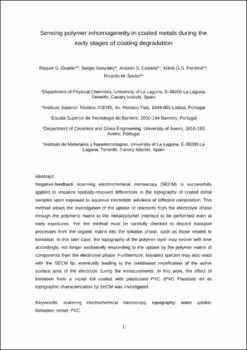Sensing polymer inhomogeneity in coated metals during the early stages of coating degradation
Fecha
2012Resumen
Negative-feedback scanning electrochemical microscopy (SECM) is successfully applied to visualize spatially-resolved differences in the topography of coated metal samples upon exposure to aqueous electrolyte solutions of different composition. This method allows the investigation of the uptake of reactants from the electrolyte phase through the polymeric matrix to the metal/polymer interface to be performed even at early exposures. Yet, the method must be carefully checked to discard transport processes from the organic matrix into the solution phase, such as those related to lixiviation. In this later case, the topography of the polymer layer may evolve with time accordingly, not longer exclusively responding to the uptake by the polymer matrix of components from the electrolyte phase. Furthermore, lixiviated species may also react with the SECM tip, eventually leading to the continuous modification of the active surface area of the electrode during the measurements. In this work, the effect of lixiviation from a nickel foil coated with plasticized PVC (PVC Plastisol) on its topographic characterization by SECM was investigated






